Skeletal System
1/77
There's no tags or description
Looks like no tags are added yet.
Name | Mastery | Learn | Test | Matching | Spaced |
|---|
No study sessions yet.
78 Terms
What parts make up the skeletal system?
Bones, joints, cartilages, ligaments
How many bones are in the body?
206
2 Subdivisions of the Skeleton
Axial, appendicular
Skull, vertebral column, thoracic cage
Axial skeleton
Pectoral girdle, upper limbs, pelvic girdle, lower limbs
Appendicular skeleton
Two sets of bones in the skull
Cranium, facial
What are bones joined by?
Sutures
Attached by a freely movable joint
Mandible
Fibrous membranes separating cranial bones
Fontanelles/soft spots
Replace fontanelles
Bones, become sutures
Hollow portions of bones surround the nasal cavity
Sinuses
Functions of paranasal sinuses
Lighten skull, give resonance + amplification to voice
Doesn’t articulate with another bone
Hyoid
Serves as a moveable base for the tongue
Hyoid
Aids in swallowing and speech
Hyoid
Extends from the skull to the pelvis
Vertebral column
Composed of vertebrae (24)
Vertebral column
Supports the head and trunk of body
Vertebral column
Protects the spinal cord
Vertebral column
Types of vertebrae
Cervical, thoracic, lumbar, sacrum, coccyx
7 vertebrae
Cervical vertebral
12 vertebrae
Thoracic vertebral
5 vertebrae
Lumbar vertebral
Both have one vertebrae
Sacrum, coccyx
Supports the shoulder girdle and arms
Thoracic cage
Protects the visceral organs in the chest and upper abdomen
Thoracic cage
Made of ribs and sternum
Thoracic cage
12 pairs - 2 floating
Ribs
1 long bone with 3 divisions
Sternum
Supports arms
Pectoral girdle
Made of clavicle, scapula, humerus, radius, ulna, olecranon process, hand
Pectoral girdle
Amount of clavicle
2
Amount of scapula
2
Upper arm
Humerus
Lower arm
Radius
Lower arm, elbow
Ulna
On ulna
Olecranon process
Hand parts
Carpals, metacarpals, phalanges
Wrist
Carpals
Hand
Metacarpals
Fingers
Phalanges
2 coxal bones that come together to form the pelvis
Pelvic girdle
Strong, stable support for the vertebral column
Pelvic girdle
Attaches lower limbs to axial skeleton
Pelvic girdle
Pelvic girdle parts
Ilium, ischium, pubis
Lower Limbs
Femur, patella, tibia, fibula, foot
Thigh
Femur
Kneecap
Patella
Lower leg-shin
Tibia
Lower leg-lateral
Fibula
Foot Parts
Tarsals, metatarsals, phalanges, talus, calcaneus
Connects lower leg to foot
Talus
Heel bone
Calcaneus
Ankle
Tarsals
Foot
Metatarsals
Toes
Phalanges
Types of bones
Long, short, flat, irregular
Parts of Long Bones
Epiphysis, epiphyseal disk, articular cartilage, diaphysis, medullary cavity, periosteum, compact, spongy
The end of the bone that forms a joint with another bone
Epiphysis
Growth plate - dark line at epiphysis where growth takes place
Epiphyseal disk
Cartilage that covers the ends of bones - serves to cushion + decrease friction
Articular cartilage
Main shaft of the bone
Diaphysis
Contains bone marrow, a specialized soft connective tissue
Medullary cavity
Lined by endosteum
Medullary cavity
Makes RBCs, WBCs, platelets
Red bone marrow
Stores fat
Yellow bone marrow
Tough vascular covering of the bone that functions to form and repair bone tissue
Periosteum
Tightly tied packed tissue that makes up the diaphysis; very strong
Compact bone
Spongy inner portion of the bone that makes up the epiphysis; helps reduce the weight of the bone; provides strength at the ends of bones
Spongy bone
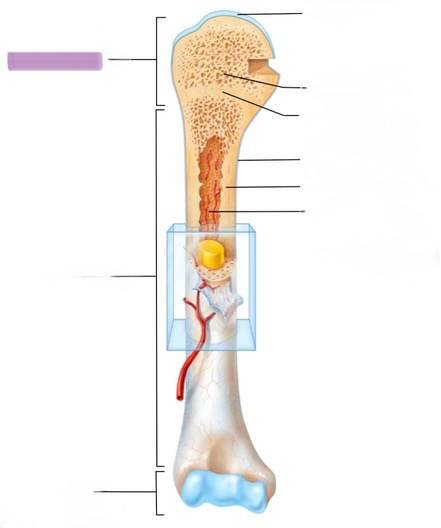
Proximal epiphysis
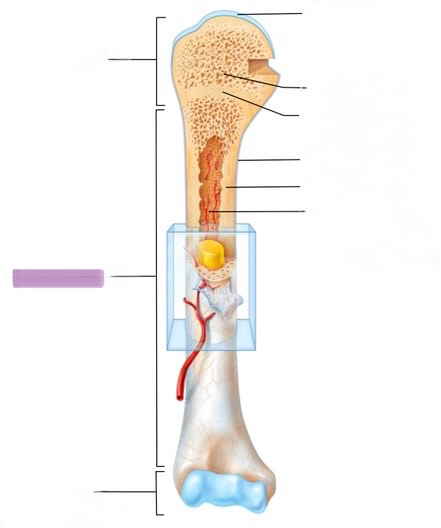
Diaphysis
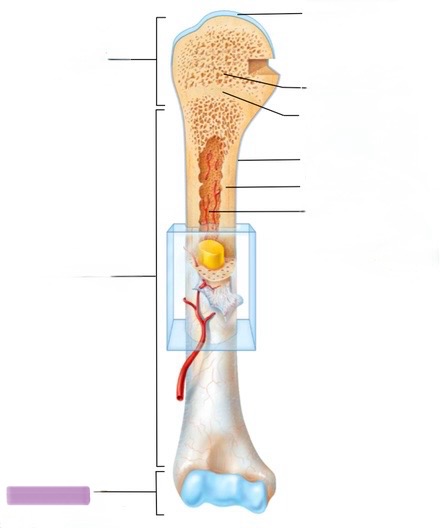
Distal diaphysis
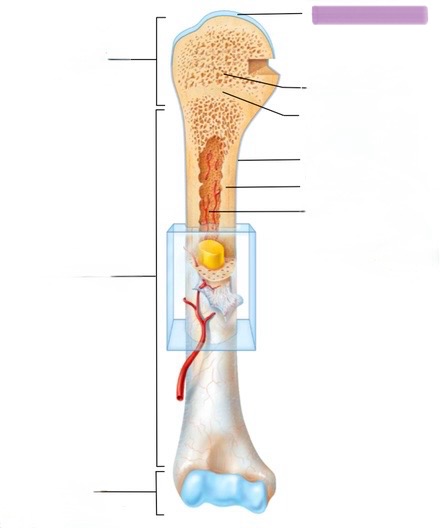
Articular cartilage
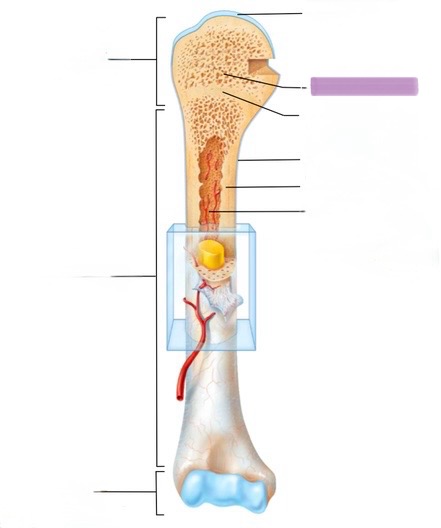
Spongy bone
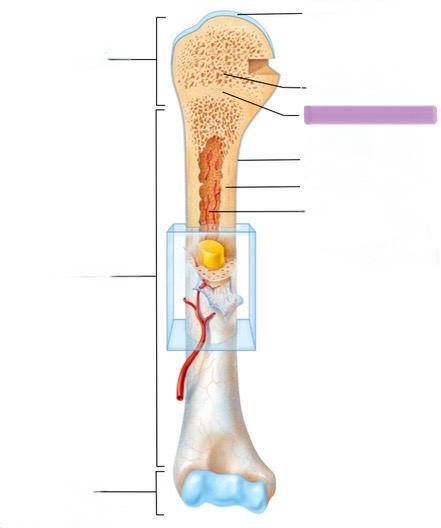
Epiphyseal disk
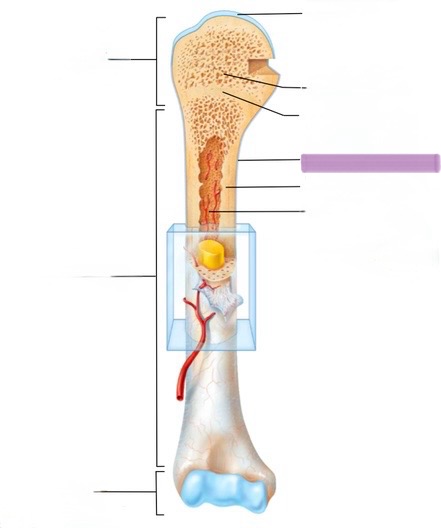
Periosteum
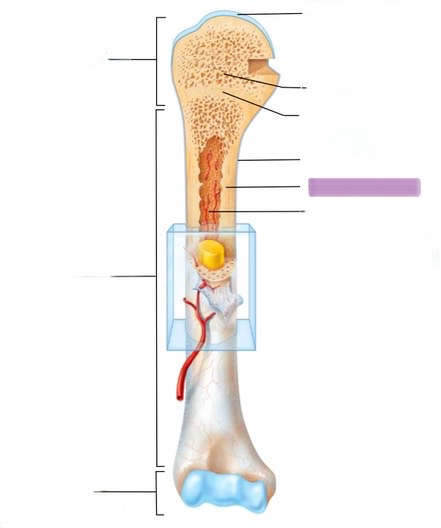
Compact bone
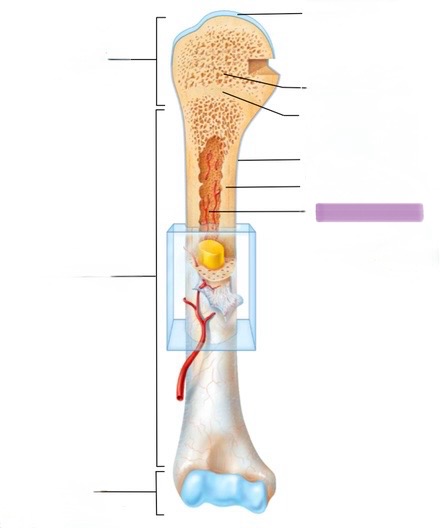
Medullary cavity